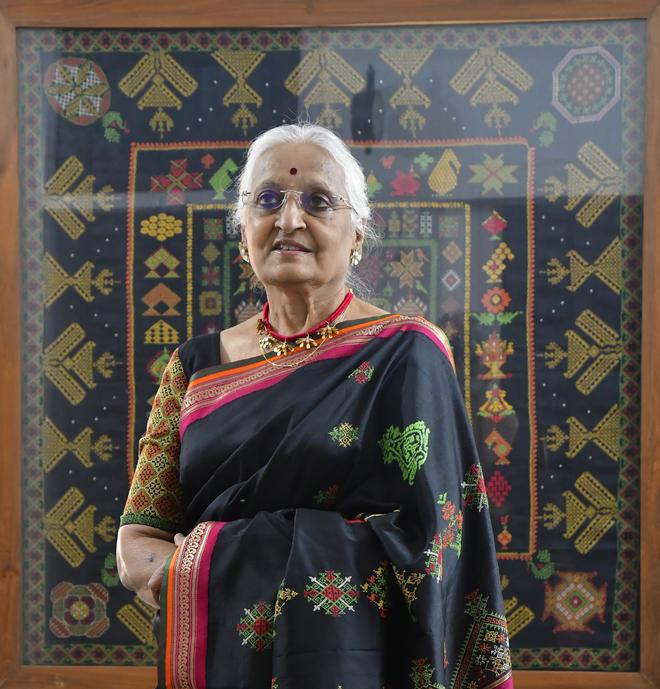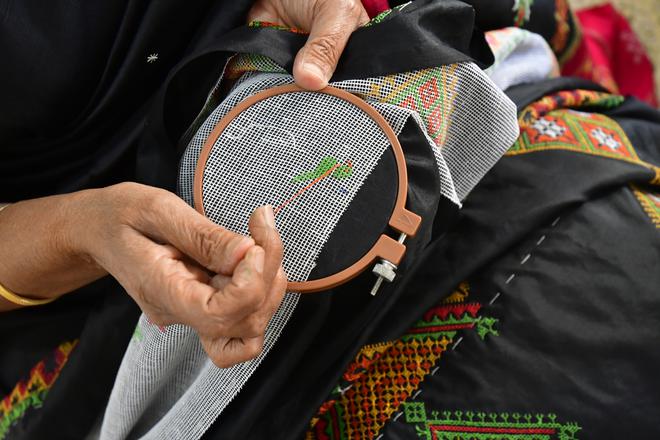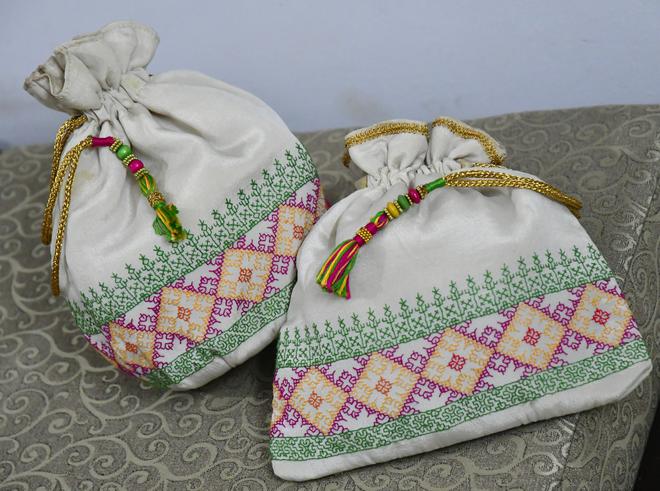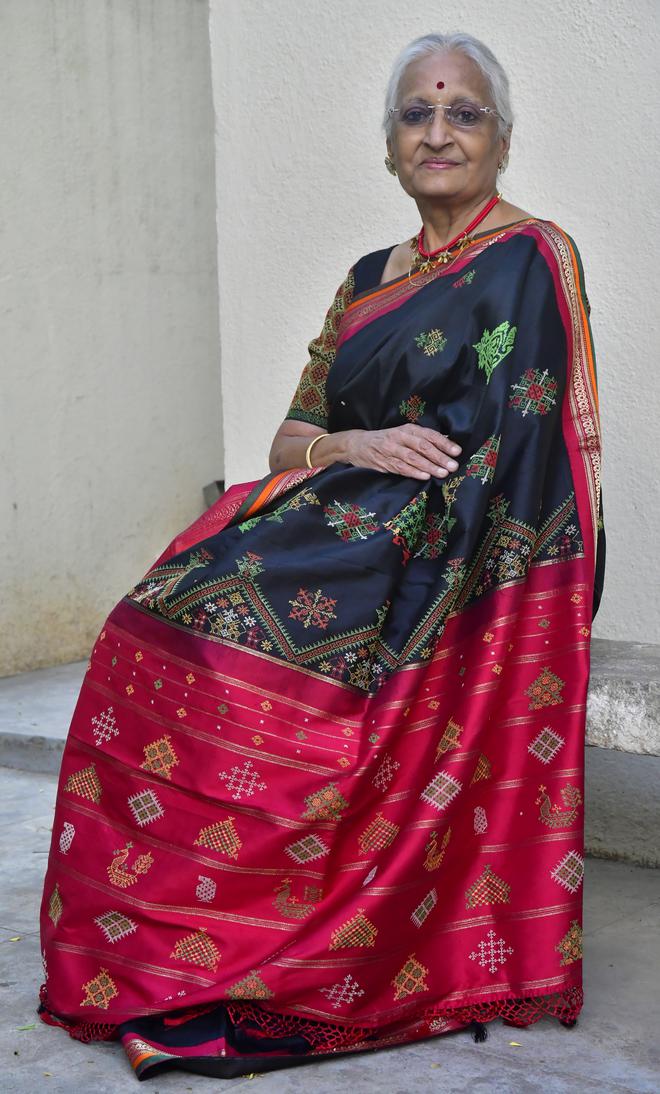“A great deal remains to be done to pull handmade kasuti embroidery back from the brink of obscurity as it competes with computerised versions entering the market,” laments Usha J Pawar, a Bengaluru-based kasuti expert who bagged the 2016 National Award for this art form.
“Today, the designs are printed beforehand and the artiste merely adds to it. The number of people learning the art are also dwindling, as it is a laborious process,” says Usha, who has trained thousands of women to take up this method of embroidery.
This style of embroidery has a regal past with researchers saying it was developed during the Vijaynagar period, though some accounts take it to the Chola era when embroidered saris were a part of the royal trousseau. The style came into being when women collected the waste material after a sari was woven in silk-rich Karnataka and used the threads for embroidery.
Cynosure of all eyes
On entering Usha’s aesthetically laid out home in Seshadripuram, one can see various embroidered works on display that exude elegance, expertise and her passion for arts and crafts. The huge piece of kasuti work that won her the National Award is displayed in her drawing room, and her needle’s attention to detail is breathtaking.

“Yes, this piece (42 x 42 inches) done on raw silk took me two years to make. It is an example of the authentic kasuti work of Hubli-Dharwad in North Karnataka. It starts without a knot and ends without a knot — the piece is reversible too, with both the back and front being identical,” says Usha.
In a nutshell, that describes what one should look for in genuine kasuti work — the absence of hanging or knotted thread.
Winning style
All the four variations of kasuti embroidery are a part of Usha’s award-winning piece. That includes gavanti, which goes diagonally, horizontally and vertically; murgi that traverses a zig-zag path; negi, also called the weaver’s stitch, is used in designs that require two strands of the embroidery thread; and menthe, a cross-stitch of sorts is used to fill in the motifs.

Describing the piece, Usha says, “I began from the centre with a chaape (carpet) of designs that represent North Karnataka, made up of what women generally observed in nature — flora, fauna and temple art with rangoli patterns.”
Just as the sanctum sanctorum of the temple is surrounded by guardian walls showcasing several pieces of art, Usha’s piece too starts off with the centre depicting the auspicious mantapa and gopura with Shiva linga, the chariot parades, trees with birds, parrots, deer, elephants and peacocks. Each surrounding rectangle in the huge spread, showcases her signature touches including the mythical bird ganda-berunda and other floral motifs that receive geometrical ornamentation.
Usha explains, “We use a single thread (embroidery thread comes in six strands) and its in the judicious use of different coloured threads that we get the right effect. Kasuti is best seen on a dark-coloured background as the designs stand out. It takes about six to eight weeks to complete a sari.”
Array of designs
Why did she choose doing kasuti on such a huge scale as a display piece? “This piece is a compilation of my observations over the decades. I came across wonderful designs in some time-honoured pieces, in danger of being forgotten. At first I thought of replicating all these designs onto a sari, but soon realised it would not be enough.” With nearly 250 designs on the piece, Usha has used 13 metres of running fabric to help demarcate them.

The dark piece of raw silk includes thread work in different shades of green, orange, red, yellow and white. “I began working on this piece in 2014 and I complete 10 years of working on the cause of kasuti. This piece can be kept for posterity and serves as a reference of everything kasuti,” says Usha. Her saris were also on display at a show curated by Prasad Bidapa, a few years ago.
Start of a mission
Usha Pawar, 73, is a Maharashtrian whose family settled in Bengaluru generations ago. Usha was born and brought up in Basavanagudi, and married Janardhan Pawar, the grandson of R Subba Rao, from the founding family of Rukmini Hall in Chickpete which deals with silk.
Usha was not particularly interested in embroidery when she was young, but appreciated the intricacies of kasuti, something her aunts scrupulously worked on. “Anchor had a design studio in Bangalore on Double Road and they held a workshop there in 1990 where I learnt about different kinds of embroidery.”
“That’s how I got on to kasuti and that passion soon developed into an obsession. Once, a customer at Rukmini Hall wanted a customised kasuti sari. In those days, it was difficult to get this done from North Karnataka, so I took up the project and that marked the beginning of my journey.”
Preserving through promotion
Today, Usha takes kasuti classes at her residence and conducts workshops as well; she is a regular at Sumanagali Ashram and the Malleswaram Enterprising Women’s Society.

She is also part of LTI in Malleswaram (Learn Teach and Interact) where ladies share ideas on several interesting topics including culture, crafts, cooking and gardening.
She has diversified her kasuti work and adds them to dupattas, tops, handbags and potlis to help preserve the art form.
Any tips to maintain a work of Kasuti? “Authentic Kasuti on any material has to be ironed on the reverse; dry cleaning is the safest way to wash,” she says.







